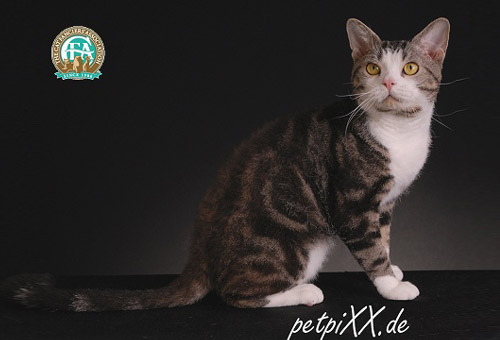

The American Wirehair breed is uniquely American. It began as a spontaneous mutation in a litter of upstate New York farm cats in 1966. A spontaneous mutation is an uncommon, although not rare, happening. As it has occurred among cats in the past, two ordinary cats came together, and as a result of their mating, a kitten unlike its parents or littermates was born. The progeny of the original mutation, Council Rock Farms Adams of Hi-Fi, are now in all areas of the United States. What is interesting and unusual about this particular mutation is that it has not been reported in any other country thus far.
 The coat is the characteristic that separates the American Wirehair from all other breeds. Just as there is a wide variety of texture in Persians or Exotics, there is also considerable variation among the Wirehairs. As this is a dominant mutation, approximately half of the kittens will be wirehaired at birth. The most readily apparent wiring is that of the whiskers, and ideally, the entire coat will be wired at birth. If the coat appears to be ringlets, it may be too long and may wave or straighten with maturity. Some of the lightly wired coats may continue to crimp during the early life of the Wirehair. The degree of coarseness depends upon the coat texture of the sire and dam. To produce the best wiring, both parents must have a hard coat.
The coat is the characteristic that separates the American Wirehair from all other breeds. Just as there is a wide variety of texture in Persians or Exotics, there is also considerable variation among the Wirehairs. As this is a dominant mutation, approximately half of the kittens will be wirehaired at birth. The most readily apparent wiring is that of the whiskers, and ideally, the entire coat will be wired at birth. If the coat appears to be ringlets, it may be too long and may wave or straighten with maturity. Some of the lightly wired coats may continue to crimp during the early life of the Wirehair. The degree of coarseness depends upon the coat texture of the sire and dam. To produce the best wiring, both parents must have a hard coat.
It was felt at first that, since this mutation had occurred in the domestic American cat, the standard for it should conform to that of the American Shorthair. However, there were unique Wirehair qualities besides the coat that kept cropping up in each litter and were worth keeping, including the higher cheekbones accentuating the face and separating it from the American Shorthair breed. The American Shorthair is still an allowable outcross for the breeding programs for the wirehairs. Wirehairs were first accepted for CFA registration in 1967 and for Championship competition in 1978.
 Breeders find them easy to care for, resistant to disease, and good producers. Pet owners delight with their quiet, reserved and loving ways.
Breeders find them easy to care for, resistant to disease, and good producers. Pet owners delight with their quiet, reserved and loving ways.
Pricing on American Wirehairs usually depends on type, applicable markings and bloodlines distinguished by Grand Champion (GC), National or Regional Winning (NW or RW), or Distinguished Merit (DM) parentage. The DM title is achieved by a dam (mother) having produced five CFA Grand Champion/Premier (alter) or DM offspring, or a sire (father) having produced fifteen CFA Grand Champion/Premier or DM offspring. Usually breeders make kittens available between twelve and sixteen weeks of age. After twelve weeks, kittens have had their basic inoculations and developed the physical and social stability needed for a new environment, showing, or being transported by air. Keeping such a rare treasure indoors, neutering or spaying, and providing acceptable surfaces (e.g. scratching posts) for the natural behavior of scratching (CFA disapproves of declawing or tendonectomy surgery) are essential elements for maintaining a healthy, long and joyful life. For more information, please contact the Breed Council Secretary for this breed.